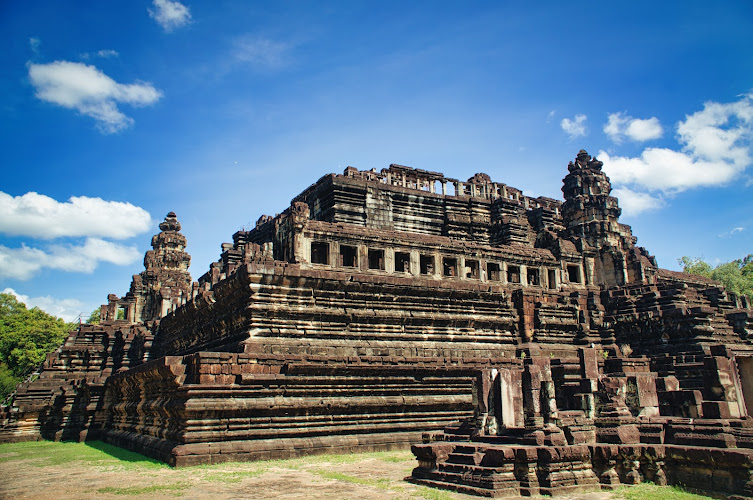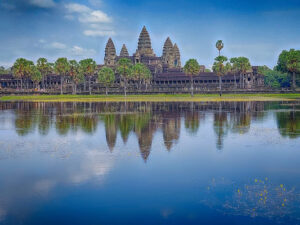
About Baphuon
Description
The Baphuon stands as one of Angkor's most remarkable architectural feats - a massive three-tiered temple mountain that literally touches the clouds. As I gazed up at its towering form during my recent visit, I couldn't help but marvel at how 11th-century builders created such an awe-inspiring structure. The temple served as the state temple of King Udayadityavarman II and showcases the [grandeur of ancient Khmer architecture](https://www.science.gov/topicpages/s/south+indian+temple.html). What really sets the Baphuon apart is its unique pyramidal structure, which rises dramatically through three distinct levels. But here's the thing - getting to fully appreciate this temple wasn't always possible. It actually spent decades hidden from visitors while French archaeologists meticulously reconstructed it stone by stone, like the world's largest 3D puzzle. The restoration was finally completed in 2011, and boy was it worth the wait!Key Features
• Magnificent 50-meter central tower that dominates the skyline • Elaborate stone carvings depicting scenes from Hindu mythology • [Massive elevated platform that](https://www.scribd.com/document/258597271/Proceedings-Kongju) provides stunning views of the surrounding jungle • Iconic eastern gopura (entrance pavilion) with intricate decorative elements • Hidden 70-meter long reclining Buddha image incorporated into the western wall • Original sandstone blocks featuring delicate bas-reliefs • Five entrance gates adorned with mythological figures • Series of galleries showcasing classical Angkorian art • Ceremonial walkway lined with boundary stones • Masterful architectural transitions between each tierBest Time to Visit
Early morning, right when the temple opens around 7:30 AM, is absolutely magical here. The sun casts long shadows across the ancient stones, and the crowds haven't arrived yet. Trust me on this - I learned the hard way after initially visiting during midday when both the heat and tourist numbers were at their peak. The best months to explore are November through February when temperatures are milder and rainfall is minimal. That said, if you're up for a more adventurous experience, visiting during the rainy season (June to October) has its own charm. The stone takes on deeper hues, and the surrounding vegetation turns an incredibly vivid green.How to Get There
Getting to the Baphuon is pretty straightforward since it's located right in the heart of Angkor Thom. You'll find it just south of the Royal Palace area - can't miss it! Most folks hire a tuk-tuk driver for the day or join a guided tour, which I personally recommend for first-timers. If you're feeling energetic, you can also reach it by bicycle from Siem Reap, though I'd suggest starting early to beat the heat. The entrance is through a raised causeway that's quite a sight itself. And yes, you'll need an Angkor Archaeological Park pass to visit - don't forget to get one before heading out!Tips for Visiting
Let me share some hard-earned wisdom from my multiple visits to the Baphuon. First off, wear proper shoes - those steep stairs aren't joking around! I once saw someone trying to climb in flip-flops, and it wasn't pretty. The steps are pretty narrow and quite worn, so sturdy footwear is an absolute must. Bring plenty of water and maybe a small towel. The climb to the top can be challenging, especially in Cambodia's heat, but the panoramic views make every step worth it. Oh, and don't forget your camera - the morning light creates some absolutely stunning photo opportunities. Remember to dress respectfully - this is still a religious site. Keep your shoulders and knees covered. I always pack a light scarf just in case. Also, while the temple is gorgeous at sunset, they usually start clearing visitors out about an hour before closing time, so plan accordingly. If you're interested in understanding the temple's rich history and symbolism, consider hiring a licensed guide. They'll point out details you might otherwise miss, like the hidden Buddha image that took me three visits to finally notice! The temple can get busy during peak hours, but there's a neat trick - while everyone rushes to the central tower, take your time exploring the outer galleries first. They're usually quieter and filled with fascinating details that many visitors overlook. Lastly, be patient with photography. The temple's size makes it tricky to capture in one shot, and the lighting can be challenging. Sometimes the best views come from unexpected angles - I found some amazing perspectives from the corners of the second tier that most guidebooks don't mention. Remember to take moments to simply absorb the atmosphere. Sit for a while in one of the quieter corners and imagine what this place was like nearly a thousand years ago. These peaceful moments often become the most memorable parts of your visit.Description
The Baphuon stands as one of Angkor’s most remarkable architectural feats – a massive three-tiered temple mountain that literally touches the clouds. As I gazed up at its towering form during my recent visit, I couldn’t help but marvel at how 11th-century builders created such an awe-inspiring structure. The temple served as the state temple of King Udayadityavarman II and showcases the [grandeur of ancient Khmer architecture](https://www.science.gov/topicpages/s/south+indian+temple.html).
What really sets the Baphuon apart is its unique pyramidal structure, which rises dramatically through three distinct levels. But here’s the thing – getting to fully appreciate this temple wasn’t always possible. It actually spent decades hidden from visitors while French archaeologists meticulously reconstructed it stone by stone, like the world’s largest 3D puzzle. The restoration was finally completed in 2011, and boy was it worth the wait!
Key Features
• Magnificent 50-meter central tower that dominates the skyline
• Elaborate stone carvings depicting scenes from Hindu mythology
• [Massive elevated platform that](https://www.scribd.com/document/258597271/Proceedings-Kongju) provides stunning views of the surrounding jungle
• Iconic eastern gopura (entrance pavilion) with intricate decorative elements
• Hidden 70-meter long reclining Buddha image incorporated into the western wall
• Original sandstone blocks featuring delicate bas-reliefs
• Five entrance gates adorned with mythological figures
• Series of galleries showcasing classical Angkorian art
• Ceremonial walkway lined with boundary stones
• Masterful architectural transitions between each tier
Best Time to Visit
Early morning, right when the temple opens around 7:30 AM, is absolutely magical here. The sun casts long shadows across the ancient stones, and the crowds haven’t arrived yet. Trust me on this – I learned the hard way after initially visiting during midday when both the heat and tourist numbers were at their peak.
The best months to explore are November through February when temperatures are milder and rainfall is minimal. That said, if you’re up for a more adventurous experience, visiting during the rainy season (June to October) has its own charm. The stone takes on deeper hues, and the surrounding vegetation turns an incredibly vivid green.
How to Get There
Getting to the Baphuon is pretty straightforward since it’s located right in the heart of Angkor Thom. You’ll find it just south of the Royal Palace area – can’t miss it! Most folks hire a tuk-tuk driver for the day or join a guided tour, which I personally recommend for first-timers. If you’re feeling energetic, you can also reach it by bicycle from Siem Reap, though I’d suggest starting early to beat the heat.
The entrance is through a raised causeway that’s quite a sight itself. And yes, you’ll need an Angkor Archaeological Park pass to visit – don’t forget to get one before heading out!
Tips for Visiting
Let me share some hard-earned wisdom from my multiple visits to the Baphuon. First off, wear proper shoes – those steep stairs aren’t joking around! I once saw someone trying to climb in flip-flops, and it wasn’t pretty. The steps are pretty narrow and quite worn, so sturdy footwear is an absolute must.
Bring plenty of water and maybe a small towel. The climb to the top can be challenging, especially in Cambodia’s heat, but the panoramic views make every step worth it. Oh, and don’t forget your camera – the morning light creates some absolutely stunning photo opportunities.
Remember to dress respectfully – this is still a religious site. Keep your shoulders and knees covered. I always pack a light scarf just in case. Also, while the temple is gorgeous at sunset, they usually start clearing visitors out about an hour before closing time, so plan accordingly.
If you’re interested in understanding the temple’s rich history and symbolism, consider hiring a licensed guide. They’ll point out details you might otherwise miss, like the hidden Buddha image that took me three visits to finally notice!
The temple can get busy during peak hours, but there’s a neat trick – while everyone rushes to the central tower, take your time exploring the outer galleries first. They’re usually quieter and filled with fascinating details that many visitors overlook.
Lastly, be patient with photography. The temple’s size makes it tricky to capture in one shot, and the lighting can be challenging. Sometimes the best views come from unexpected angles – I found some amazing perspectives from the corners of the second tier that most guidebooks don’t mention.
Remember to take moments to simply absorb the atmosphere. Sit for a while in one of the quieter corners and imagine what this place was like nearly a thousand years ago. These peaceful moments often become the most memorable parts of your visit.
Location
Places to Stay Near Baphuon
Find Tours in Krong Siem Reap
Explore More Travel Guides
No reviews found! Be the first to review!


